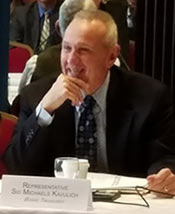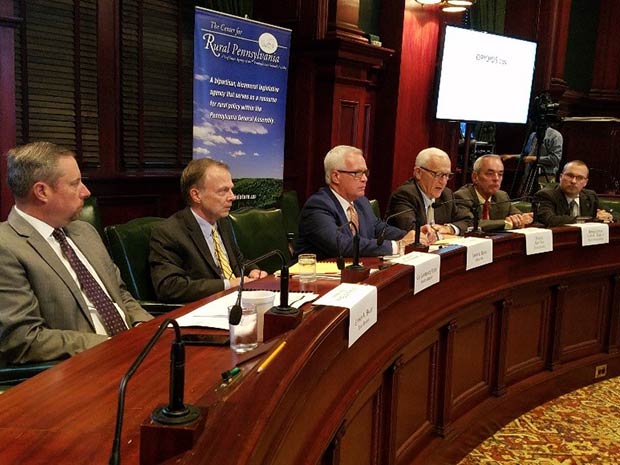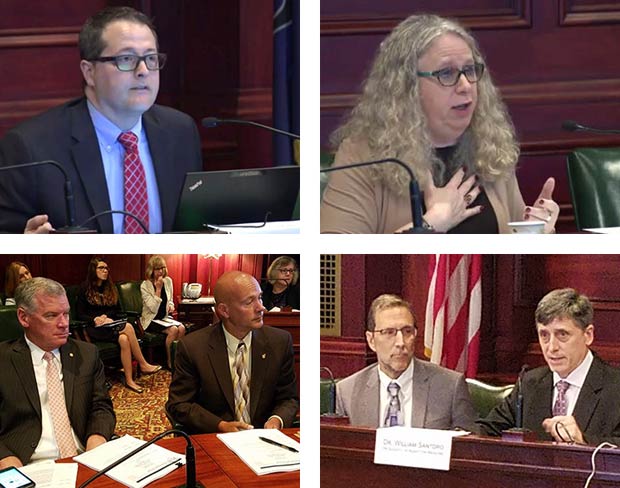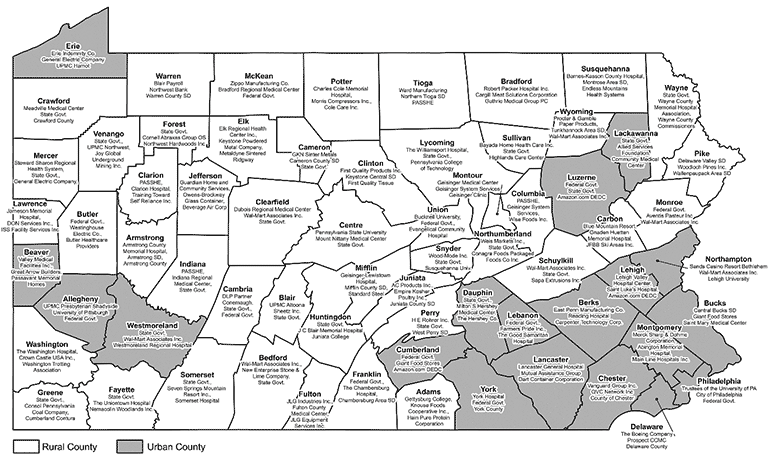Newsletters
- Home
- Publications
- Newsletter Archive
- Newsletter
November/December 2018
Inside This Issue:
- Research Provides First Statewide Inventory of Historic Preservation Ordinances
- Take the Broadband Speed Test
- Chairman's Message
- Center Mourns Passing of Board Treasurer Kavulich
- Rural Snapshot: Top Three Employers by County in Pennsylvania, First Quarter 2018
- Center Board Convenes Public Hearing on the State of Addiction
- Just the Facts: Historical Markers
Research Provides First Statewide Inventory of Historic Preservation Ordinances
The first comprehensive statewide inventory and analysis of historic preservation ordinances in Pennsylvania municipalities is now available. The analysis was conducted by researchers at Shippensburg University of Pennsylvania and Millersville University of Pennsylvania to determine the extent to which Pennsylvania municipalities had enacted local ordinances under the authority of the Historic District Act (HDA) of 1961 and the Municipalities Planning Code (MPC) of 1968.
The research, sponsored by the Center for Rural Pennsylvania, involved a variety of research methods, including surveys, interviews, in-depth analyses of a sample of municipal ordinances, and geo-spatial mapping. The research was conducted by Dr. Steven Burg, Dr. George Pomeroy, Antonia Price, Taylor Little, and James Hughes of Shippensburg University, and Dr. Angela Cuthbert, Dana Edsall, and Zachary Moore of Millersville University.
Overall, the research team identified 294 municipalities (not including Philadelphia and Pittsburgh) that have enacted one or more types of historic preservation regulations. These municipalities comprise about 12 percent of the state’s 2,562 municipalities. Of the 294 municipalities identified, 105, or about 4 percent of the state total, have enacted HDA empowered ordinances, and 195, or about 8 percent, used MPC authority to enact zoning ordinances that provide for historic preservation. The research found that a small number of municipalities employ both MPC and HDA ordinances. Also, 26 municipalities have provisions for historic resource preservation in their subdivision and land development ordinances.
The research found that 215 municipalities with historic preservation provisions are urban and 79 are rural. Rural municipalities with historic preservation ordinances are generally located in the eastern (25) and central (43) regions of the state, with only 11 located in the western region.
In terms of municipality types, there are 128 second class townships, 124 boroughs, 21 cities, 20 first class townships, and one town with historic preservation ordinance provisions.
The research also uncovered a range of documented current practices operating under the authority of the MPC to protect historic resources. For example, in a sample set of ordinances containing historic preservation language, the research found the most common regulatory provisions are: restrictions/delays on demolition of historic structures; review of alterations; the use of historic overlay districts; and design guidelines.
The research also found that municipalities that engage in historic preservation typically have certain sociodemographic characteristics, such as higher per capita incomes, greater median home values, higher rates of population growth, and greater population densities. These municipalities also tend to have populations with higher educational attainment levels and lower median ages.
Based on the findings, the research team developed several policy considerations, including the following:
- Revise the MPC to require county comprehensive plans to be more detailed in specifying the historic resources counties wish to preserve, and the specific actions being taken at the county or municipal level to protect those resources. A list of municipalities with historic preservation ordinances should be a required element in all county comprehensive plans.
- Expand the Pennsylvania State Historic Preservation Office (SHPO) Community Preservation Coordinators Program.
- Increase SHPO support for rural county planning offices.
- Extend better state oversight and reporting of MPC-related historic preservation activity.
- Sustain funding for the Keystone Historic Preservation Grants Program.
- Continue funding for the Pennsylvania Historic Preservation Tax Credit program.
- Provide historic preservation grants for low-income homeowners.
- Expand the role of the Pennsylvania Department of Community and Economic Development and SHPO in promoting historic preservation as an economic development tool, and update the mission of the HDA and MPC to reflect the economic development value of historic preservation.
The report, Inventory and Analysis of Historic Preservation Ordinances in Pennsylvania Municipalities, is available here.
Take the Broadband Speed Test
Help the Center and our research partners at Penn State University map broadband access throughout Pennsylvania by taking the broadband speed test at http://broadbandtest.us/. The test is part of the Center-sponsored research, Broadband Availability and Access in Rural Pennsylvania, and the results will help Penn State researchers, led by Professor Sascha Meinrath, to measure actual internet speeds in Pennsylvania.
The test also provides participants with information about their broadband connection.
Help us map broadband access in Pennsylvania and click here to take the test.
Thanks for your help.
Chairman's Message
According to the Federal Communications Commission (FCC), 800,000 Pennsylvanians don’t have broadband internet access. That’s 6 percent of the state’s population. A majority of that population lives in rural Pennsylvania.
For example, in northeastern Pennsylvania, 29 percent of the population in Tioga County, 39 percent of the population in Bradford County, 30 percent of the population in Potter County, 69 percent of the population in Sullivan County, and 11 percent of the population in Lycoming County do not have access to fixed, advanced telecommunications.
Why is this important? Because broadband access means so much more than interactive gaming or connecting with your family and friends on social media. Broadband access means connecting with your healthcare provider during a home evaluation so the visiting nurse can update your medical records during the visit. Broadband access means that your child can complete and then submit a classroom assignment at home. Broadband access means that a small business can take online reservations and accept a down payment on that reservation from the customer’s credit card.
Because broadband access is so important, the Center’s board awarded a grant to Penn State University researchers to help determine the amount of high-speed access in rural Pennsylvania and to produce corresponding maps of legislative districts to help legislators make informed decisions about the issue in the communities they serve.
That research is now in its final months, and as researchers are still collecting the data they need, they are asking all Pennsylvanians to help them map broadband access in Pennsylvania by taking the broadband speed test at http://broadbandtest.us/. As noted on Page 1, the test provides participants with information about their broadband connection, as well.
We encourage you to take the broadband speed test, because this research will provide valuable insight into broadband connectivity throughout Pennsylvania. It will also help the legislature as it considers optimal ways to expand broadband service throughout our rural communities.
On a separate and very sad note, on behalf of the Center’s board and staff, I offer our deepest condolences to Rep. Sid Michaels Kavulich’s family and friends. I appreciated Sid’s strong support and involvement in the Center’s work. He will be missed.
Senator Gene Yaw
Center Mourns Passing of Board Treasurer Kavulich

It is with deep sadness that the Center for Rural Pennsylvania mourns the loss of Board Treasurer Rep. Sid Michaels Kavulich. Rep. Kavulich passed Tuesday, October 16, due to complications from heart surgery earlier in the month.
“Rep. Kavulich cared deeply about Pennsylvania and was a strong advocate for our rural residents and communities,” said Sen. Gene Yaw, board chairman. “We were fortunate to have Sid on the board and will remember him for his integrity, thoughtfulness, and leadership. He will be sorely missed.”
Rep. Kavulich served on the Center’s Board of Directors since 2015. He was first elected to the state House of Representatives in 2011 and served on the Agriculture and Rural Affairs, Finance, Gaming Oversight, Tourism and Recreational Development, and Local Government committees.
Rural Snapshot: Top Three Employers by County in Pennsylvania, First Quarter 2018
The data are from the Pennsylvania Department of Labor and Industry. In the dataset, employers are ranked by the number of employees. Employers must be covered under the state or federal unemployment compensation (UC) system to be included in the data. Due to confidentiality, the department does not provide the number of employees for individual employers.
Note: Employer names are presented as reported by the Pennsylvania Department of Labor and Industry. Some employers may be doing business
Center Board Convenes Public Hearing on the State of Addiction
To learn and share more information about the disease of addiction, and the treatment options that are available to combat heroin and opioid addiction, the Center for Rural Pennsylvania held its 15th public hearing on Tuesday, October 2 at the State Capitol Building in Harrisburg.
Center Board Chairman Senator Gene Yaw said the Center Board convened this hearing because, oftentimes, addiction is seen as a moral failing, and not a disease.
“We must remove the stigma around the disease of addiction, and highlight the medication assisted treatment options that are available, such as methadone, buprenorphine and vivitrol,” he said.
Panelists at the public hearing were Dr. Bradley Miller, a Fellow of the American Academy of Family Physicians at UPMC Susquehanna in Williamsport, Pennsylvania’s Secretary of Health and Physician General Dr. Rachel Levine, and Dr. Frederic Baurer, president, and Dr. William Santoro, public policy chair, of the Pennsylvania Society of Addiction Medicine.
A link to the testimony presented at the hearing is available here, and a link to a video of the hearing is available here.

Pictured left to right: Center Board Member Steve Brame, Center Board Member Dr. Lawrence Feick,
Center Director Barry Denk, Center Board Chairman Sen. Gene Yaw, Center Board Vice Chairman Rep. Garth Everett,
and Center Board Member Darrin Youker.

Pictured clockwise from top left: Dr. Miller, PA Health Secretary Dr. Levine; Dr. Santoro and Dr. Baurer,
and Sen. Patrick Stefano, and Sen. Thomas McGarrigle.
Just the Facts: Historical Markers
Those blue roadside markers with gold lettering that you see scattered around our state are signs that history is alive and well in Pennsylvania. The Pennsylvania Historical and Museum Commission (PHMC) established the historical marker program to recognize and celebrate our state’s rich history. These historical markers tell the tale of the person, place or event that made history in that spot.
According to PHMC data, there are 2,483 historical markers: 41 percent of which are in rural areas and 59 percent of which are in urban areas.
An informal classification of these markers indicate that 23 percent of the markers in rural areas and 30 percent of the markers in urban areas highlight the accomplishments of individuals or families. Examples of this type of marker in rural areas include: Joseph Priestley, 18th Century scientist; and Rear Admiral Robert Edwin Peary, arctic explorer.
In rural areas, 19 percent of the markers recognize towns, communities, and settlements. In urban areas, 11 percent of the markers recognize these places. Examples of these types of markers in rural areas include: Pithole City, an oil boomtown in Venango County; Kuskusaies Towns, Native American settlements in Lawrence County; and Ole Bull’s Colony, an immigrant community in Potter County.
There is a higher percent of signs in rural areas (12 percent) highlighting transportation (highways, bridges, canals, etc.) than in urban areas (7 percent). Examples of these markers in rural areas are the Switchback Railroad, the Sinnemahoning Path, and Dingman’s Ferry.
According to PHMC’s database, the earliest marker was dedicated in 1914 (Fort McCord in Franklin County). Seven signs were dedicated in 2018. Examples of the more recent markers are Dewey’s Sit-in in Philadelphia, and George H. Earle III in Delaware County.
The average dedication date for rural markers was 1963. The average dedication date for urban markers was 13 years later in 1976.
The next time you’re out and about and see one of these blue and gold markers, why not stop and read a little something about Pennsylvania’s rich history.

